Contents
Basic Cement Chemistry
TO DOWNLOAD THE MOST IMPORTANT BOOKS , MANUALS , OPERATION NOTES , FORMUFLAS , EXCEL SHEETS CLICK HERE NOW !! WHAT ARE YOU WAITING FOR ??!!
Learning Objectives
- Know the meaning and the way of presentation of chemical and mineralogical composition of cement specific materials
- Know the chemical moduli applied for cement specific materials
- Know the Bogue-calculation for clinker mineral phases and the relationship with chemical moduli
- Chemical Composition
- Chemical Formulae
- Mineralogical Composition
- Chemical Parameters for Cement-Specific Materials
- Contents of Clinker Minerals According to Bogue
- Relationship between Chemical Moduli and Clinker Mineral Contents
- Exercise for Calculation
Elemental Composition (weight – %)
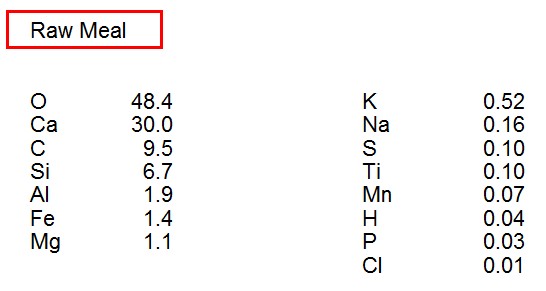
Chemical Composition
- Elemental composition in weight percentage. By convention, the elements are expressed in form of their oxides (exception; Cl, F).
- Usual sequence of elements in cement chemistry
- L.o.I.: e.g. at 1050 °C, mainly due to CO2 and H2O
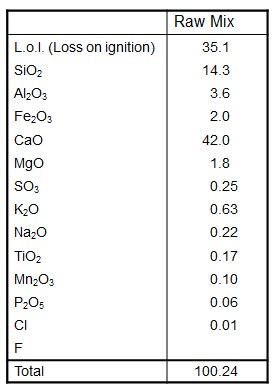
Chemical Composition – Examples
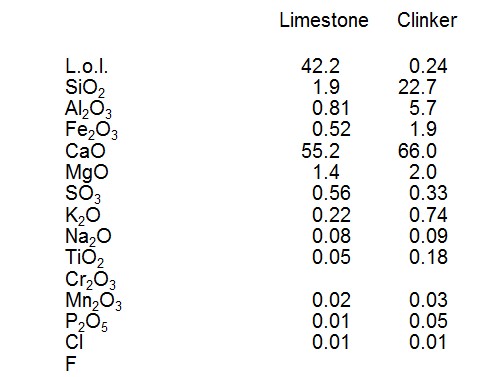
Chemical Formula
- The chemical formula indicates the elements occurring in a chemical compound:
For a molecular compound, type and absolute number of elements are given

For a mineralogical compound, type and relative number of elements are given

Note: In mineralogical compounds, the elements need not necessarily occur in simple numerical ratios (impurities, solid solution)
Chemical Formulae
In the cement chemistry, shorthand’s are often used:

Mineralogical Composition
Composition of material, expressed in weight-percentage of the occurring minerals

Note: Difference between chemical and mineralogical composition

Chemical Parameters for Cement-Specific Materials
Titration
Content of carbonates as determined by acid-base titration, expressed as CaCO3
% Titration = 1.786 CaO + 2.48 MgO
Applied for: Limestone Marl Raw Meal
Lime Saturation

The LS is a measure to which extent the CaO-richest compounds C3S, C3A and C4AF can be formed without the necessary presence of free lime. At LS > 100, free lime will unavoidably be present after burning.
Applied for:
Raw meal
Clinker
Cement: neat OPC only
CaO = CaO(total) – 0.7 SO3
Usual range in clinker: 85 – 100
Note: The influence of MgO can be accounted for

Max. 2% MgO may be introduced in formula (not applied in cement specifications)
Silica Ratio

Applied for:
Siliceous-argillaceous raw components
Raw Meal
Clinker
Cement
Usual range in clinker: 1.8 – 3.6
Alumina Ratio

Applied for:
Siliceous-argillaceous raw components
Raw Meal
Clinker
Cement
Usual range in clinker: 1 – 3
Na2O-equivalent
Total alkali content, expressed as Na2O
Na2O-equivalent = Na2O + 0.658 K2O
Note:
Limit for low alkali cement
Na2O-equivalent < 0.6 %
Applied for:
Clinker
Cement
Moduli of Main Clinkers in Holcim group
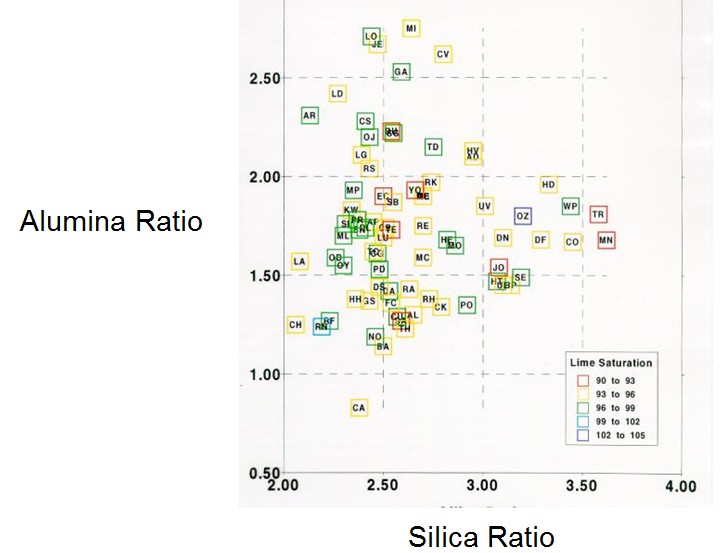
Moduli of Main Clinkers
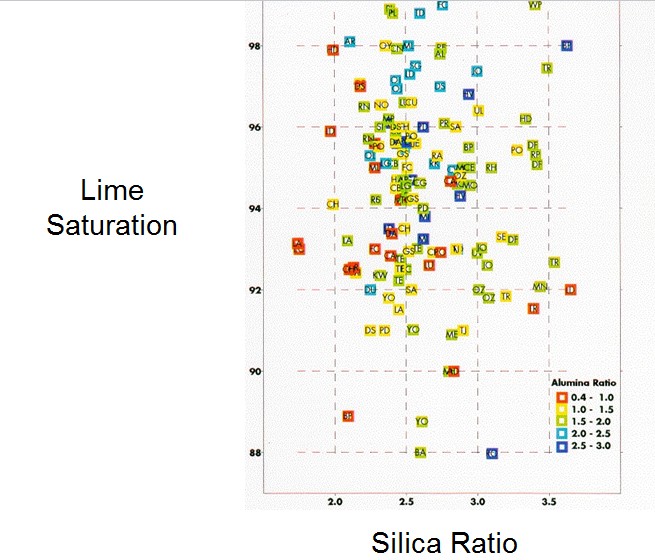
Content of clinker Minerals according to Bogue
- Percentage content of clinker minerals, assuming that chemical equilibrium is attained, and that no impurities are present.
C3S = 4.07 CaO – 7.6 SiO2 – 6.72 Al2O3 – 1.43 Fe2O3
C2S = 8.6 SiO2 + 5.07 Al2O3 + 2.08 Fe2O3 – 3.07 CaO
or 2.87 SiO2 – 0.754 C3S
C3A = 2.65 Al2O3 – 1.69 Fe2O3
C4AF = 3.04 Fe2O3
In reality, the mineralogical composition of industrial clinkers differs to some extent from that calculated according to Bogue.
Applied for Cement
– OPC only (excl. blended cements)
– Correction for CaO in CaSO4: CaO = CaOtot – 0.70 SO3
– For AASHTO: TiO2 and P2O5 to be added to Al2O3 (no longer for ASTM)
Clinker
– CaO can be corrected for free lime; depending on objective of calculation CaO = CaOtot – CaOfree
Significance of Clinker Minerals for Cement Properties
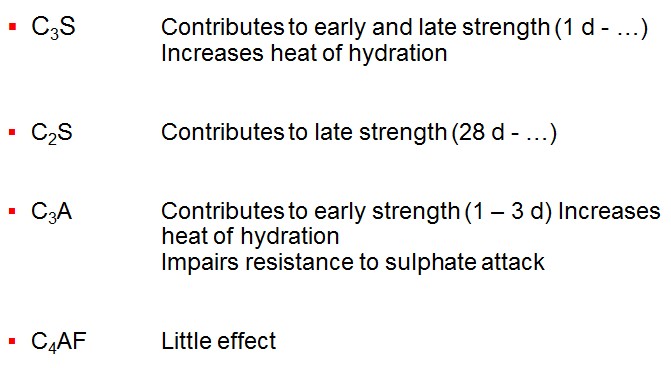
Significance of Clinker Minerals for ASTM Cement Types
- Type I Portland no restrictions regarding clinker minerals
- Type II Portland with moderate sulphate resistance (and moderate heat of hydration)
C3A max. 8 %
(C3S + C3A max. 58% for moderate heat of hydration)
- Type III Portland with high early strength
C3A max. 15% (C3A max. 8% for moderate sulphate resist. C3A max. 5% for high sulphate resist.)
- Type IV Portland with low heat of hydration
C3S max. 35%
C2S min. 40%
C3A max. 7%
- Type V Portland with high sulphate resistance
C3A max. 5.0 %
C4AF + 2 C3A max. 25%
or C4AF + 2 C2F max. 25%
Clinker Minerals as Function of LS

Clinker Minerals as Function of SR

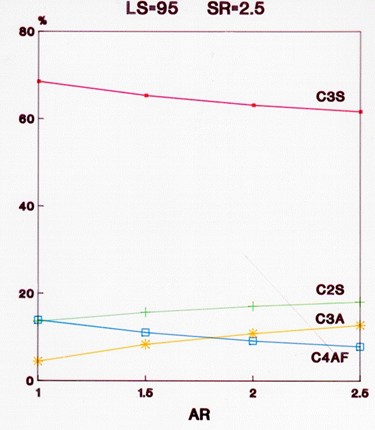
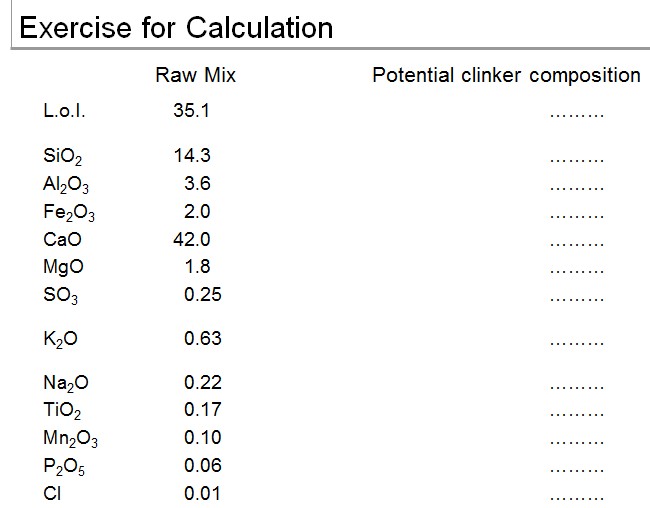
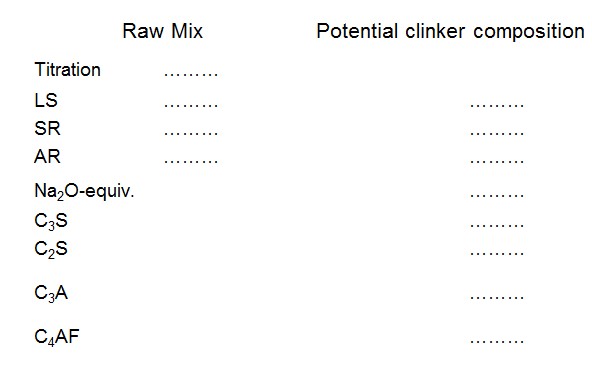
if you have any Question , don’t Hesitate to contact our chemical section , send an Email with Subject CHEMI(02)
to Email : project20062015@gmail.com
TO DOWNLOAD THE MOST IMPORTANT BOOKS , MANUALS , OPERATION NOTES , FORMUFLAS , EXCEL SHEETS CLICK HERE NOW !! WHAT ARE YOU WAITING FOR ??!!
I am Hendy Alheety director of quality control at the Kubaisa cement plant very interested in scientific bullentins and hop that I receive constantly …… thanks
I hop receve constantly
Hello Hendy, I’ll be glad to share technical information, regarding sample preparation. Please contact me at csalas@scancia.ca
Regards,
Carlos
I am from iraq
I hop receve constantly
I am Simon SIHE, maintenance manager from LafargeHolcim Guinea. Thanks for this.
As per quality checks there are several factors involved in Cement chemist in that mainly Cement strength ex- for OPC – one day strength should be 18 to 20 MPA A as per BIS (Bureau of Indian standard) for 7 days it should be 46 to 48 MPA and for 28 days it should be 53 MPA minimum etc
I am JOAO JAYME IESS, process and technical consultant for many Cement Industries in Brasil, I really apreciate to receive more of such excelente literature.
you can find more at our fb page : https://www.facebook.com/cementequipment.org/
I have learned more about cement chemistry.
Thank you
I really appreciate for such excellent lecture,I have learned more about chemistry of cement.
I really appreciate of receiving excellent literature.
Plz come and to our group at whata app with near 120 cement engineers from several country all around the world .there are technical discusion & sharig practice in the field of their plant problems ..
My whats app number :
+989126596689
mahdi dalband
Tnkx ..